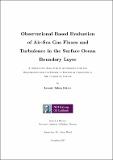| dc.contributor.advisor | Ward, Brian | |
| dc.contributor.author | Esters, Leonie Tabea | |
| dc.date.accessioned | 2018-04-09T15:02:23Z | |
| dc.date.available | 2018-04-09T15:02:23Z | |
| dc.date.issued | 2018-04-09 | |
| dc.identifier.uri | http://hdl.handle.net/10379/7262 | |
| dc.description.abstract | Turbulence within the ocean surface boundary layer (OSBL) is an important
quantity for many processes as it mixes the ocean and transports various
ocean quantities such as pollutants, heat, and dissolved gases. However,
direct observations of the dissipation rate of turbulent kinetic energy \epsilon under
open ocean conditions are limited. Consequently, our understanding on how
to model turbulence and its related processes is constrained.
Open ocean measurements from the Air-Sea Interaction Profiler (ASIP)
from five cruises are combined with ship-based meteorological information,
direct measurements of air-sea gas fluxes, and wave data from dedicated runs
of the ECWAM wave model. This comprehensive data set allowed for an
evaluation of commonly applied approaches to scale profiles of \epsilon, as well as
to formulate a scaling relationship. During daytime conditions a relationship
based on the friction velocity and wave age describes the observations best.
During conditions when convection dominates over wind and wave-induced
turbulence the scaling considers buoyancy forcing as additional source for
turbulence.
This data was also used to quantify the so-called small-eddy model under
open-ocean conditions. This theoretical model relates air-sea gas transfer
directly to turbulence, rather than often used empirical wind speed-based
parameterisations. It can be shown that the agreement between the model
and observations can be improved when using a variable Schmidt number
exponent in the model, rather than a constant value of 1/2.
Further analysis of a single deployment of ASIP in the Labrador Sea
presents a unique situation where a stably stratified diurnally warmed
OSBL is accompanied by a mixing event, which is most plausibly explained
by a breaking internal wave. These results manifest the importance of
observations in the upper ocean for understanding processes for oceanatmosphere
exchange. | en_IE |
| dc.publisher | NUI Galway | |
| dc.rights | Attribution-NonCommercial-NoDerivs 3.0 Ireland | |
| dc.rights.uri | https://creativecommons.org/licenses/by-nc-nd/3.0/ie/ | |
| dc.subject | air-sea gas exchange | en_IE |
| dc.subject | ocean turbulence | en_IE |
| dc.subject | upper ocean | en_IE |
| dc.subject | ocean surface boundary layer | en_IE |
| dc.subject | diurnal warming event | en_IE |
| dc.subject | internal wave breaking | en_IE |
| dc.subject | Physics | en_IE |
| dc.subject | Science | en_IE |
| dc.title | Observational based evaluation of air-sea gas fluxes and turbulence in the surface ocean boundary layer | en_IE |
| dc.type | Thesis | en |
| dc.contributor.funder | College of Science, National University of Ireland, Galway | en_IE |
| dc.local.note | Open-ocean measurements of turbulence within the surface layer of the ocean from various research cruises were used together with meteorological and wave information were used to parameterise this turbulence and to evaluate their impact on air-sea gas exchange and diurnal warming. | en_IE |
| dc.local.final | Yes | en_IE |
| nui.item.downloads | 520 | |


